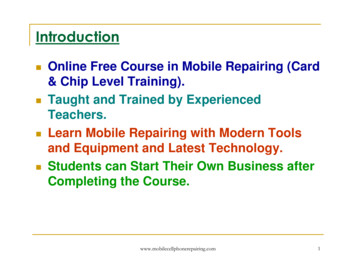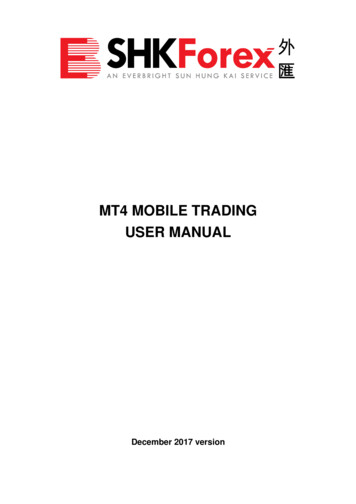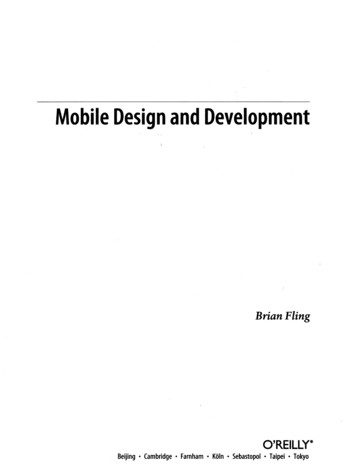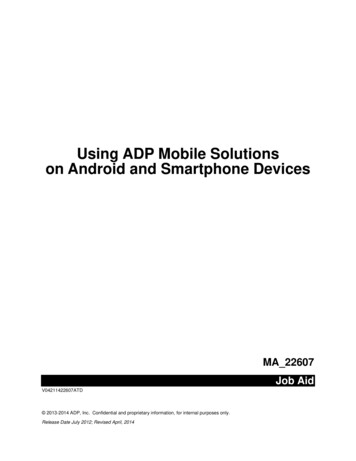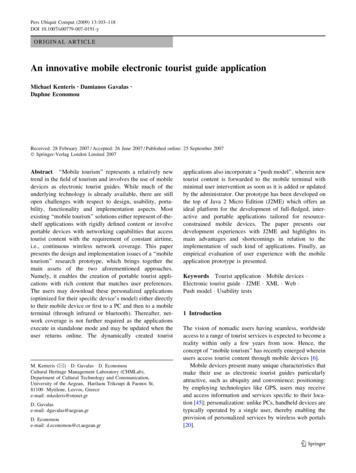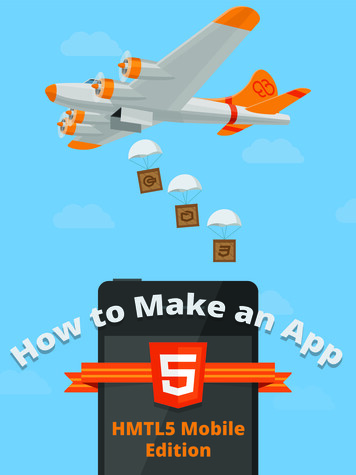
Transcription
HMTL5 MobileEdition
How to Make an App: HTML5 Mobile EditionPerhaps you are a web developer looking to leverage your current skillset on mobile platforms. Or maybe you are an iOS or Android developer looking to enhanceyour skills with web technologies. Whatever your background, if you want yournext mobile app to reach a huge market, then you should consider writing it inHTML5.Even before HTML5 became an official W3C (World Wide Web Consortium) standard in December 2012, developers — even big ones like Facebook (see sidebar)— were jumping onboard. HTML5 offers a very compelling “write once – run anywhere” value proposition. There are also thousands more developers with HTML5skills than there are developers with iOS or Android development skills. Furthermore, the number of HTML5-compatible phones on which your application couldpotentially run is very large — expected to top 1 billion in 2013, according to theresearch firm Strategy Analytics.Let’s look at what it takes to write an HTML5 mobile app — what an app consists of, what are some of the more popular tools available to help you throughthe process — and explore why (or why not) you might choose to go the HTML5route. But let’s start with a look at what HTML5 is and what it does.Page 2 of 35
HTML5 is a SpecLike its name implies, HTML5 is the fifth official version of HTML, the specification of the markup language for structuring and presenting content on theWorld Wide Web. Unlike a “programming” languagesuch as, for example, Objective-C (the language ofiOS apps), a markup language is not compiled, whichmeans it isn’t converted into a file of machine-executable binary code. An HTML5 app is a plain old webapp that a web browser loads and renders as the webpages we are all familiar with.Like any web page, an HTML5 app may need to bedownloaded at runtime or, alternatively, it can bepackaged as a self-contained app that runs in itsown web view and that many people might findindistinguishable from a “native” app.Unlike an HTML5 app, a native mobile app is one thatis written specifically for a particular mobile operating system (iOS, Android, etc.) using the programming language, libraries and other tools supportingthat OS. Those tools include APIs that apps can callto leverage device-specific functions directly from theOS, including camera, accelerometer, storage, andothers.Unlike previous HTML standards, HTML5 also supports APIs on devices as well as other features, previously missing in the standard, that make HTML5 aviable language for mobile app development. It is thefirst HTML version to support multimedia withoutplugins (like Flash, which is not supported on manyPage 3 of 35An HTML5 app is aplain old web app thata web browser loadsand renders as theweb pages we are allfamiliar withClick to tweet
How to Make an App: HTML5 Mobile Editionphones). HTML5 also integrates CSS3 (Cascading StyleSheets 3) and JavaScript, making it possible to implement “beefier” apps directly in the HTML5 standardwhose user experience (UX) rivals that of native appsin terms of high visual appeal and high interactivity. Infact, it is fair to say that many of HTML5’s innovationsare there so that HTML5 apps can be “just as good”as native versions — or even better because they allow developers to reach the largest audience with theleast amount of effort. Let’s look more closely at the“web vs. native” debate.Page 4 of 35
HTML5’s Advantages Over“Going Native”First of all, the HTML5 vs. native choice does not haveto be an either/or type decision — given that the bestapplications run on multiple form factors and that theweb is not going away. That said, different environments do have their advantages. Whether you decide to go the HTML5 or native route (at least initially)largely depends on whether: A rich user experience is a high priority You want to monetize the application You’re in a hurry to put the application on multipleplatforms You’re looking to collaborate with a large pool ofdevelopers You want to change the application and contentfrequentlyWhile HTML has raised its game in terms of user experience with HTML5, native does still hold an edge(for mobile), as it does also in monetization — for reasons we will explore in the next section under native’sadvantages. For now, let’s look at three factors mostlyfavoring HTML5 mobile development:Support for Multiple PlatformsOne of the major reasons HTML5 was created, asjust noted, was so developers could write one implementation of an application and have it run moreor less the same everywhere with a high degree ofPage 5 of 24The HTML5 vs. nativechoice does not haveto be an either/or typedecisionClick to tweet
How to Make an App: HTML5 Mobile EditionWriting the app oncein HTML5 can avoidthose extra costs andget your app up andrunning on a myriad ofplatforms much morequickly.Click to tweetinteractivity and visual appeal. The motivation behindthat goal is easy to understand given that there areat least five major platforms: iOS, Android, Blackberry, Windows Phone 7/8, and Symbian — with over 28implementations of Android alone by multiple manufacturers, including Google, Motorola, Samsung, HTC,Kindle, Sony, and others. So let’s say you do whatmany organizations do, which is to write the app firstfor iOS because you want to show off cutting edge design and because all iPhones run the same version ofiOS. Then you want to achieve that same experienceon Android (including its many versions). That secondeffort usually means building out a whole separateteam, which can easily double or even triple the costof the new version. But then you also have to buildout a team for each of the platforms as well. Writingthe app once in HTML5 can avoid those extra costsand get your app up and running on a myriad of platforms much more quickly.Proponents of a native approach might then argue,“Yes, sure, but what about all the different browsers and different versions of browsers that are outthere? Don’t you have to account for those differences, too?” There are in fact over 200 different types ofavailable browser interpretations of HTML5. On theother hand, you can argue that only a small portion ofthose 200 really matter and that tweaking a programto run on a different browser version is much easier than writing a new implementation from scratch.There are also tools like Modernizr and PhoneGap(both discussed later) that remove much of the burden of making HTML5 apps work cross-browser oreven (in the case of PhoneGap) cross-platform. Another approach is simply to put feature detectionlogic in your code to see whether something is supported in a particular browser (so you can provide anPage 6 of 35
How to Make an App: HTML5 Mobile Editionalternative execution thread if it’s not). A good example is the @supports tag in CSS and css.supports inJavaScript to detect browser support for a given styledirective.Large Open Collaborative CommunityOrganizations have spent the last 15 years investingin web technologies and skills — much longer thanthey have in mobile app development — so it’s probably safe to say that there are many more HTML andJavaScript developers than there are (for example)Objective-C developers. This is backed up by the ranking of projects in GitHub and the number of questions in StackOverflow. Also, as the web matures andthe number of new traditional websites coming online declines, many of these web developers can beexpected to compete for jobs on mobile app projects.This all means that companies will have many moreHTML and JavaScript developers from which to pickthan they will developers skilled in any specific mobileplatform (and so companies can also expect to payless for them). The good news for HTML5 developersskilled in writing mobile apps is that they should be atthe front of the line for the most interesting and highest paying jobs. What’s also good news is that thereare many more free resources available, and a lotmore knowledge sharing, in the web community thanyou’ll find when developing for a native platform.Changing the Application FrequentlyOne “native” advantage is the opportunity for anapp to be highlighted in an “app store,” thereby easing distribution and monetization. The downside ofgoing through an app store, however, is that it putsthird-parties like Apple, Google and Microsoft between you and your customer — so they have ultimate control of how fast apps and updates becomePage 7 of 35HTML5 developersskilled in writing mobile apps should befirst in line for thehighest paying jobsClick to tweet
How to Make an App: HTML5 Mobile Editionavailable to your customers. If you want users to getapp updates frequently, giving those updates directly via a website or email link is the fastest way to go.Every time a user logs into the web app, they get themost recent version of the program. HTML5 is alsopreferred if you want to serve users who opt to neverdownload an app.Page 8 of 35
“Going Native” AdvantagesOver HTML5The two advantages often cited for native implementations are in user experience and monetization. Let’stake a look at each:Rich User ExperienceIn a recent Compuware APM survey, 85% of mobiledevice users said they prefer native mobile apps overmobile websites (i.e., HTML implementations). Thetop three reasons were: Apps are considered more convenient Apps are faster Apps are “easier to browse” (i.e., navigate)Clearly users want apps that help them do what theywant to do fast — hence, the survey results. Nativeapps respond more quickly to touch events and lagless when users scroll. On the other hand, as networkbandwidth continues to increase and as HTML toolsbecome better at producing more efficient code, thespeed gap between native and HTML implementations for a large percentage of app types will close.Another performance gap is the ability of HTML5apps to access native device functions like geolocation, camera and accelerometer. HTML5 does includeAPIs to the most popular device features, includingGPS location and accelerometer, and is adding more.That’s “most” but certainly not all. Native APIs outnumber HTML5 APIs by a huge amount — a numberPage 9 of 35The two advantagesoften cited for nativeimplementations arein user experience andmonetizationClick to tweet
How to Make an App: HTML5 Mobile Edition that just keeps growing. Apple, for example, introduced 1,500 new APIs with iOS 7, including AirDropand AirPlay. So, if your app relies heavily on APIs toaccess external functions or services, you may wantto think about a native implementation.One exception — where HTML5 implementations dohave a performance advantage — is shopping andweather apps. Both rely heavily on user analytics,which web-based apps can access and provide faster.MonetizationOf course, the reason many people develop apps isto sell them. And selling apps has become a very bigbusiness. Apple’s App Store holds over 400 millioncustomer accounts, including credit card information,making it the largest transactional site on the Internetin terms of number of participants. Those customershave downloaded over 50 billion apps and Apple haspaid out over 5 billion to developers. Google’s ownapp store, Google Play, now holds over 800,000 apps.The single HTML5 equivalent is Google’s ChromeWeb Store, which distributes web apps for the Google Chrome browser. The only other alternative is todistribute your app directly to the public via a websiteand accept payment the same way.Page 10 of 35
How to Make an App: HTML5 EditionThe Facebook StoryIf you’re still undecided about taking the HTML5 or the native route, you are notalone. Even the biggest names in the industry have struggled over this decision —and by their own admission have sometimes gotten it wrong.Facebook is a classic example. Speaking at the 2011 Facebook Developers Conference, here is how Facebook’s engineering manager, Dave Fetterman, explainedthe company’s decision to implement the company’s mobile app in HTML5:“Being able to write it once today and ship it tomorrow? That is something that Facebook isreally good at and that we love doing, and that is at the center of being able to move fast.Move fast has an implicit third clause — move fast, break things, and fix things fast. Thatis very difficult to do if you have already shipped your binary to Apple or Android and theyhave to download another version of it.”But only a year later Facebook announced it had since totally rebuilt the iOS version of its mobile app as a native implementation. As Facebook developer J.P.Dann wrote in a blog post:“So, we rewrote Facebook for iOS from the ground up (I really did open up Xcode and click‘New Project’) with a focus on quality and leveraging the advances that have been made iniOS development.”So why the reversal? The native iOS version loads faster, loads news feeds faster,scrolls faster and is generally more responsive. As Dann explains in his blog:“One way we have achieved this is by re-balancing where we perform certain tasks. For example, in iOS, the main thread drives the UI and handles touch events, so the more work wedo on the main thread, the slower the app feels. Instead, we take care to perform computationally expensive tasks in the background. This means all our networking activity, JSONparsing, NSManagedObject creation, and saving to disk never touches the main thread.”The move appears to have worked. As Mashable reported, following the new version’s release, ratings jumped from 1.4 to 5 stars in just a few weeks.Page 11 of 24
Choose your ToolsAnother factor that weighs in on the “HTML5 or native” decision is the selection of tools you may chooseto develop your app. HTML5 programs consist ofthree main components: the HTML text markup language for page layout, CSS3 for style, and JavaScriptfor in-browser execution of program code. And although it is possible to sit down at a text editor andjust write your code, there are tools that streamlinethe process considerably. These include: Basic frameworks (e.g., Backbone, Ember.js, Angular) that supply “prefab” structures on which tobuild a finished app instead of starting from scratch Enhance frameworks (e.g., JQuery Mobile, Enyo,Sencha Touch) that provide extra help such as prebuilt widgets (e.g., buttons) and CSS auto code generation Hybrid app frameworks (e.g., PhoneGap) that turnHTML5 apps into native apps for iOS, Android, Windows Phone, and other mobile platformsSome developers may like working with these toolsmore than they like working with native tools. Perhaps they find them easier to use, or the tools letthem more easily reach more users with better quality code.A look at how some of these tools benefit developershelps show why HTML5 is often a great choice for implementing mobile apps.Page 12 of 35Some developersmay like working with[HTML5] tools morethan they like workingwith native toolsClick to tweet
How to Make an App: HTML5 Mobile EditionJQuery Mobile (jQM)This is a “touch optimized” framework, meaning thatit offers special widgets that streamline the writing offeatures (like buttons) important on a mobile phone.It’s also “platform agnostic,” meaning that it is compatible with all major mobile platforms as well asall major desktop browsers, including iOS, Android,Blackberry, Symbian, Windows Phone 7, and more. Itis built on top of jQuery (a JavaScript library meant tosimplify client-side scripting) so it has a minimal learning curve for people already familiar with jQuery syntax.Other key features include: Theming framework that allows creation of customthemes Limited dependencies and lightweight to optimizespeed The same underlying codebase will automaticallyscale to any screen HTML5-driven configuration for laying out pageswith minimal scriptingTo use JQuery, you link to the JQuery Mobile librariesand stylesheet, either on the JQuery Mobile CDN (content distribution network) or after downloading andhosting locally. Like all HTML5 programs, a JQueryMobile app has a !DOCTYPE HTML document type,a header, and a body. The body consists of various“div’s” or html elements that are described by an attribute called “data-role” that tells JQM what the div contains and how it should look. Note that HTML5 madecustom “data-“ attributes possible and JQuery Mobilemakes heavy use of them, as in this example:Page 13 of 35
How to Make an App: HTML5 Mobile Edition body div data-role ”page” id ”first” data-theme ”a” div data-role ”header” h1 Page Title1 /h1 /div !-- /header -- div data-role ”content” p Page content goes here. /p Other roles could be header, content, footer, etc. Adiv with a “page” data-role represents either a singlepage or multiple internal linked pages within a page(so internal links are more responsive when tapped).Note the use of the “data-theme” attribute, whichspecifies which design theme to use for elementswithin the div, and can be set to a, b, c, d, or e. The“data-theme” is in fact one of the key ways JQueryMobile streamlines mobile app development. Ratherthan write CSS script yourself, you can use the JQueryMobile Theme Roller. It is essentially an online formthat lets you specify various styling choices, includingcolors, for buttons, pages and other elements, andthen group those styling choices together as a theme,which you label a, b, c, d, or e. Theme Roller then automatically generates the CSS code for that theme,which you can then download. To apply a theme’s CSSin your program, simply specify its letter, as in the example above.Other examples of how JQM expedites HTML5 development are data attributes “data-position” and“data-transition.” Use data-position to specify whetheran element should be fixed, in which case it will eitheralways render at the top (if a header) or at the bottom (if a footer). The data-transition attribute letsyou specify how the app transitions from one pagePage 14 of 35
How to Make an App: HTML5 Mobile Editionto another when a new page is loaded: side, slideup,slidedown, flip or fade.JQuery Mobile isn’t ideal for every app, however.Some critics may complain, for example, that JQuery Mobile apps tend to look alike and lack visualappeal. Even though developers don’t have to useJQM’s theme building features, most JQM developersdo — which means the apps might not look thatcreative.Dojo Offers Out-of-the-Box ThemesLike JQuery Mobile, the Dojo Toolkit is also a framework meant to speedHTML5-based development, especially for multi-browser support. It consists ofseveral parts: dojo contains the core and most non-visual modules dijit is a library of user-interface modules for widgets and layout dojox holds assorted modules not yet considered stable enough to include indojo or dijit util includes build tools such as optimization, documentation, style-checking,and testingLike JQuery Mobile, the Dojo Toolkit also offers themes. But rather than a servicethat lets you style your own, Dojo Toolkit offers (currently) four “out of the box”designs in dijit: Claro, Tundra, Nihilo and Soria. Other “out of the box” widgets include menus, tabs, tooltips, sortable tables, maps, gauges and more.Page 15 of 35
How to Make an App: HTML5 Mobile EditionBootstrap: “Packed with Features”Bootstrap is a popular web UI framework started by Twitter with a wide followingand large contributor base. Bootstrap 3 will have a focus on mobile and add tothe existing functionality. At the time of writing this ebook Bootstrap 3 wasn’t officially released yet.As noted on its developers’ website, “Bootstrap was made to not only look andbehave great in the latest desktop browsers (as well as IE7!), but in tablet andsmartphone browsers via responsive CSS as well.” Features include a “12-columnresponsive grid, dozens of components, JavaScript plugins, typography, form controls, and even a web-based Customizer to make Bootstrap your own.”PhoneGapJQuery Mobile and the Dojo Toolkit are usefulframeworks for quickly building apps that offer amobile-like user experience on many different browsers and on many different platforms. But what ifyou’re an HTML5 developer who also wants yourapp to run as a native app? In other words, it’s packaged as a native app, can be distributed throughapp stores, and can access native device APIs? Youalso don’t want to give up the same write once – runanywhere benefit of HTML5. You want to write theHTML5, JavaScript and CSS code once and have it natively on all the major platforms.The answer may be PhoneGap, a mobile development framework originally developed by Nitobi in2009 and then purchased by Adobe Systems in 2011.Unlike JQuery Mobile, it comes with a web-based service (PhoneGap Build) that lets you essentially put thePage 16 of 35
How to Make an App: HTML5 Mobile EditionWhat if you’re anHTML5 developer whoalso wants your app torun as a native app?Click to tweetHTML-based app inside a wrapper that makes it looklike a native app to the phone. The result is a hybridapp — hybrid because the app typically runs in a webview container and is wrapped by a native UI layer,giving access to native navigation and hooks to standard hardware events.To perform the conversion using PhoneGap Build,simply enter the web address of a repository (likeGitHub) holding your app’s HTML, JavaScript and CSS3files. You can also upload the files as a zip archive.The PhoneGap service includes a dashboard that letsyou select which platforms you want the app to runon and also insert any credentials needed to submitthe app to a platform’s particular app store. (Applehas approved apps built using the framework.) Theservice then automatically generates the hybrid app.A product that shares many of the same goals asPhoneGap — and is actually built on top of PhoneGap— is IBM’s Worklight. In addition to repackaging appsto run natively, like PhoneGap, Worklight also includes (among many other features) a Worklight Studio, a full IDE (integrated development environment)such as you might use Android Studio/Eclipse (for Android development) or Xcode (for iOS). Other featuresinclude support for mixing HTML5 and native coding,encryption of locally stored data and offline authentication — plus third-party integration with frameworkssuch as PhoneGap and JQuery Mobile.Page 17 of 35
How to Make an App: HTML5 Mobile EditionProgressive EnhancementOne of the arguments against using HTML5 for mobile apps is that differentbrowser/platform combinations support different HTML5 features. Solutions likeJQuery Mobile, Dojo and PhoneGap attack this problem by producing code thatis widely compatible across environments — leading to what some might call a“lowest common denominator” result. But what if you want your apps to take advantage of the latest and greatest HTML5 enhancements everywhere you can —or can someday when more browser support arrives? This future oriented view iscalled “progressive enhancement.” A developer who subscribes to this view maynot care that few (if any) browsers currently support a feature — the developerwill put the feature in anyway, along with feature detection logic that turns it onwhen the feature is supported someday.Developers can write that logic themselves — if/then conditional statements thattest the browser to see if the feature is present — and then branch to the appropriate code that either uses the feature or does a workaround. Another approachis to use Modernizr, a small JavaScript library of browser tests. Upon page load,Modernizr sends an instruction to the browser to test each of dozens of features.It then adds classes to the HTML based on what features are or are not supported. For example if the browser does not support HTML5’s text shadow feature,Modernizr writes a .no-textshadow element. If the answer is “true” when the program tests for that element, then a workaround might be to display the text in adifferent color — one that doesn’t need a shadow to stand out (like white text ona white background would).Building in support now for features that will be supported later means you mightnot have to update the program later, and that there is no delay between thetime a browser supports a feature and when users get to enjoy it.Modernizr may be the best known example of a class of products designed to fillgaps in browser capability at run time, but it is not the only one. Another exampleis a class of products called polyfills (or polyfillers), which takes its name from aproduct used in the UK to fill cracks in walls, like Spackle is used in the U.S.Page 18 of 35
How to Make an App: HTML5 Mobile EditionA polyfill is a downloadable piece of code that provides capabilities not built intoa web browser. There are literally dozens of polyfills available on GitHub. An example is Remy Sharp’s storage polyfill that enables IE7 AND IE6 support of localStorage and sessionStorage. For more information on polyfills, check out thePolymer Project at www.polymer-project.org.Why Won’t My Web App Perform Like aNative App?One of the ways a user can usually tell a web app is a web app is if scrolling isn’tsmooth or transitions and animations stutter across the screen. This is called a“janky UI” and it happens when the browser’s rendering engine can’t keep up withall the things the app is trying to do. The problem is that the browser only hasroughly 16ms to run all the JavaScript, perform layout, paint and do whatever elseit has to do to display the frame before it has to start all over again with the nextframe. If the browser takes longer than that interval it’s called “busting the framebudget” and the display “janks.”There are measures developers can take to prevent jank. One is to use the requestAnimationFrame (rAF) API instead of what many developers do, which isto use either setInterval or setTimeout every 16ms. The problem with these twocalls is that the developer is assuming that the system knows what a millisecond is (i.e., timing resolution is perfect) and that all screens refresh at exactly thesame rate — neither of which assumptions are correct. The clocks inside computers and smartphones are only accurate to a few milliseconds, so the software cannever know for sure how long 16ms really is. Furthermore, depending on factorslike brand of mobile device and whether background tabs are hogging resources, screen refresh rates will vary. So even if the clock inside the smartphone werePage 19 of 35
How to Make an App: HTML5 Mobile Editionperfect, the browser would still drop frames because it’s not ready to displaythem.The advantage of using rAF is that it only gets the frame when the browser isready, regardless of what the refresh rate is. It also pauses animations in background tabs, conserving resources and battery life.But rAF alone does not completely solve the problem. You still have to make surethat whatever work occurs during the rAF call takes less (hopefully, significantlyless) than 16ms. For example, don’t do a lot of process in input handlers. A lot ofjankiness happens because an app tries to perform too much JavaScript or attempts to rearrange a whole page while it is also trying to display a frame.A strategy that lets you avoid JavaScript completely in your callback is to use CSSanimations instead. Using CSS animation both simplifies your app and lets animations run smoothly even while JavaScript is running — essentially guaranteeingjank-free display performance.Which means no one may ever know or care your web app is really a web app.Page 20 of 35
How to Make an App: HTML5 Mobile EditionSample App
HowHowto Maketo Makean App:an App:HTML5HTML5MobileEditionEditionIn this example, we will show how to use some of the concepts covered so farto build, debug and deploy a mobile app that uses modern JavaScript tools andframeworks. We’re assuming you already know some basic HTML and CSS. Sorather than provide a blow-by-blow description of the application’s logic, we willwalk through the process of creating a mobile app from source code that alreadyexists in GitHub, which you can download as a zip file from . Note that this example wasoriginally conceived from the start as a mobile app rather than as a web app thatwould then be ported to mobile.The sample app, called “Applicant Tracker,” allows the user to view a list of job applicants along with some details about each applicant, such as their GitHub activity. There are three screens: a login screen (Figure 1), a main screen (Figure 2) thatFigure 1: Applicant Tracker’s loginscreenFigure 2: Main screen showingapplicant listPage 22 of 35Figure 3: Applicant detail screendisplays the GitHub profile, including avatar and follower statistics
How to Make an App: HTML5 Editionshows the applicant list, and an applicant detail screen (Figure 3). The applicantlist is stored on Kinvey (as an example of how to integrate a backend) with GitHubdetails pulled from GitHub (as an example of how to incorporate a third-party APIin a data fetch).Tools OverviewBefore getting started let’s review some of the tools you will be working with: Chrome is a modern web browser that includes Chrome DevTools to debug onthe desktop. Node.js is a server-side JavaScript framework used to run the local webserver(which will serve our app once it’s built) and our app’s build process (which isgrunt). This sample web app uses client side frameworks and libraries includingBackbone.js and LESS, a stylesheet language whose syntax grunt converts toCSS during the build. The sample app depends on various third party services: Kinvey for thebackend (data storage, user management, etc.); PhoneGap to generate nativeapps (iOS, Android, etc.); and GitHub to host source code and retrieve applicant profile data. You will need accounts and API keys for all. You can run the sample web app in any modern browser.Process OverviewWe will walk through the process of creating the app in three steps:1. Get the source code, run it in Chrome and practice debugging2. Get a Kinvey account, add a new
perience with HTML5, native does still hold an edge (for mobile), as it does also in monetization — for rea-sons we will explore in the next section under native’s advantages. For now, let’s look at three factors mostly favoring HTML5 mobile development: Support for Multiple Platforms One of
